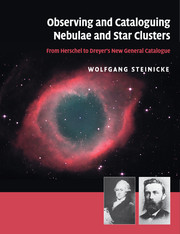Book contents
- Frontmatter
- Contents
- Preface
- 1 Introduction
- 2 William Herschel's observations and parallel activities
- 3 John Herschel's Slough observations
- 4 Discoveries made in parallel with John Herschel's Slough observations
- 5 John Herschel at the Cape of Good Hope
- 6 The time after Herschel's observations until Auwers' list of new nebulae
- 7 Compiling the General Catalogue
- 8 Dreyer's first catalogue: the supplement to Herschel's General Catalogue
- 9 Compilation of the New General Catalogue
- 10 The New General Catalogue: publication, analysis and effects
- 11 Special topics
- 12 Summary
- Appendix
- References
- Internet and image sources
- Name index
- Site index
- Object index
- Subject index
- Frontmatter
- Contents
- Preface
- 1 Introduction
- 2 William Herschel's observations and parallel activities
- 3 John Herschel's Slough observations
- 4 Discoveries made in parallel with John Herschel's Slough observations
- 5 John Herschel at the Cape of Good Hope
- 6 The time after Herschel's observations until Auwers' list of new nebulae
- 7 Compiling the General Catalogue
- 8 Dreyer's first catalogue: the supplement to Herschel's General Catalogue
- 9 Compilation of the New General Catalogue
- 10 The New General Catalogue: publication, analysis and effects
- 11 Special topics
- 12 Summary
- Appendix
- References
- Internet and image sources
- Name index
- Site index
- Object index
- Subject index
Summary
My enthusiasm for nebulae and star clusters goes back a long way – they were the targets of my first telescopic explorations of the night sky. This book treats the history of their discovery, visual observation and cataloguing. It is naturally focused on the nineteenth century – the fascinating epoch of classical astronomy, characterised by precious achromatic refractors and massive metal-mirror reflectors. Only a few astronomers searched for nonstellar objects systematically – foremost among them William Herschel and his son John. We owe to both of them the first comprehensive catalogues. The development reached its climax with the New General Catalogue (NGC) by John Louis Emil Dreyer – which is still a standard source for both amateur and professional astronomers.
Initially this immense work appeared to me as a mysterious treasure, arousing my scientific curiosity. What was behind the 7840 objects and who were the discoverers? By using the NGC, I gradually became familiar with its content. However, due to erroneous and incomplete data, it was often difficult to match the entries with the real sky. Over the years, due to my research on the historical sources and visual observing, the catalogue became a close companion. Many secrets could be disclosed – and, of course, my admiration for Dreyer increased.
- Type
- Chapter
- Information
- Observing and Cataloguing Nebulae and Star ClustersFrom Herschel to Dreyer's New General Catalogue, pp. xi - xiiPublisher: Cambridge University PressPrint publication year: 2010

